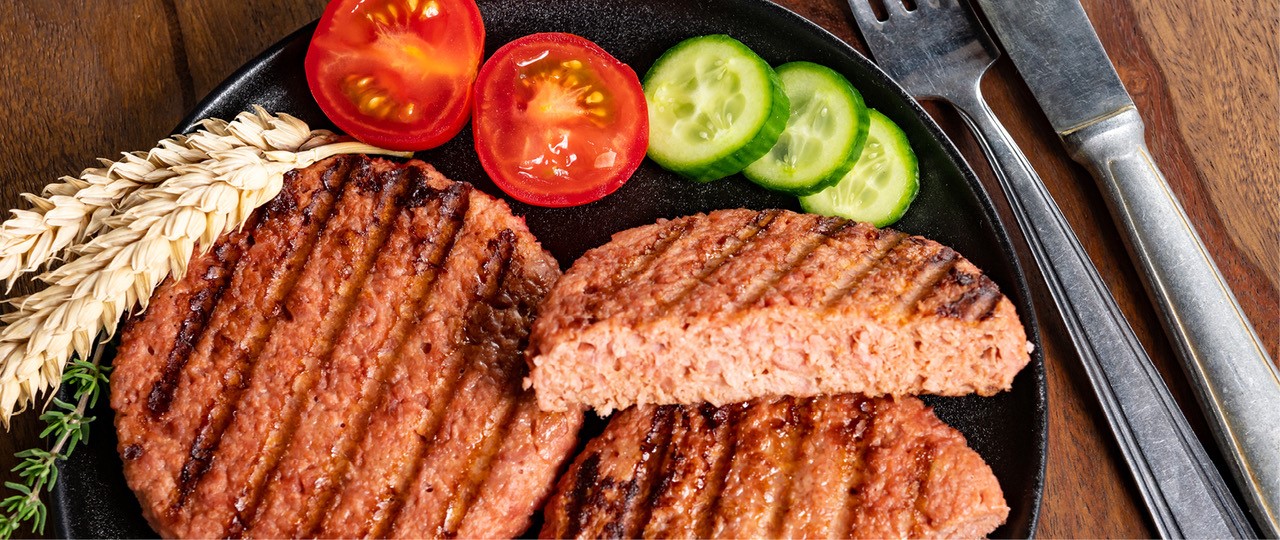
Meat analogues: from isolates to TVP
Meat analogues: then and now
Meat is an important food in the daily diet, supplying essential elements for the human body including protein and fat, and also vitamins and minerals. However, there are several factors that can influence the consumer purchase, such as price, quality, appearance, and its environmental impact. It is exactly this last factor, together with health-related reasons, that is leading a slice of conscious consumers to choose the consumption of vegetable products as a replacement for animal products.
Many of the first alternative products to meat were designed for consumers who followed vegetarian or vegan diets, therefore they were not developed with the intent of replicating animal meat, but only as a vegetable alternative. Nowadays, however, the trend has changed, and people are trying to accurately reproduce the conventional product because they are no longer niche products, but also preferred by consumers, the “flexitarians”, who want to reduce meat consumption mainly for health or environmental reasons, but do not necessarily adopt a plant-based diet.
Starting from the basics: the raw materials
Animal meat is made of protein, fat, vitamins, minerals and water, as are plants, which however lack the typical muscle tissue of meat. According to The Science of Plant-based Meat from the Good Food Institute, the biochemical similarity between plants and animals is used to produce plant-based meat, striving to best replicate the texture of conventional meat, from the simplest texture of minced meat, to the largest pieces of animal meat consisting of intact muscle tissue.
The production of vegetable meat starts with protein powders, concentrates (protein content >50%), or isolates (protein content >90%) which are then subjected to a process that modifies their structure, reproducing the fiber-like consistency of meat. Then, proteins are enriched with other ingredients to recreate the taste, color and flavor of conventional meat. In this regard, the choice of the most suitable vegetable protein is crucial, as it can influence in different ways the structure, color, texture and flavor of the final product thanks to its intrinsic features such as solubility, emulsion, foaming, viscosity, gelling.
To this day, the most widely used protein in meat analogue products has been soy, due to its high functional properties and good amino acid composition. Nevertheless, producers and consumers are gradually moving towards non-GMO protein ingredients in order to have a clean label end product. Wheat protein has also often been used as an ingredient in meat analogue products as it allows the creation of a texture similar to the conventional product due to the presence of gluten.
In recent years, pea protein has also been gaining popularity as a suitable alternative for vegetable meat production due to its good functionality, especially when used together with other proteins, for example gluten, to improve the nutritional attributes of the final product. Other proteins, such as those from rice and potato, are slowly emerging, especially as useful ingredients to formulate gluten-free meat alternatives.
Texturizing processing: from Isolate to TVP
To produce a meat-like product, vegetable proteins, in the form of protein concentrates or isolates, need to go through a number of changes from their native form (globular form) to the textured form (linear form). The extrusion process is the most patented and traditionally used for protein texturization, and currently remains one of the most popular due to its high productivity and cost compared to other technologies, although it has limitations in terms of energy consumption and quality of the final product.
According to the article Plant-based meat analogues: from niche to mainstream extrusion allows the protein conformation to be changed to create a meat-like structure, and can be low moisture (<35%) or high moisture (40-80%). Through low moisture extrusion, we can get textured proteins, known as TVPs, which are dry and once rehydrated take on a spongy texture. High moisture extrusion, on the other hand, allows to achieve a moist TVP, with a meat-like fiber structure due to better fat emulsion and protein gelation.
In order to best reproduce the features of conventional meat, TVPs must be processed and enriched with other ingredients, which help to reproduce the right texture and taste of the product.
To enhance flavor and improve texture and mouthfeel, for example, saturated and unsaturated fats including coconut, sunflower and canola oil are used. Polysaccharides are also important for the structure of meat analogues, since thanks to their thickening and emulsifying properties they improve the product ability to bind to water, improving the overall texture. Always with the same goal of working on consistency and uniformity, starches and flours are also used, such as potato, corn, wheat.
Besides this, flavoring ingredients are also very important to emulate the profile of meat, or even to mask possible off-flavors typical of vegetable proteins. Finally, coloring agents such as beet juice or leghemoglobin are added to make the product attractive to the consumer’s eye, giving it the typical red color of meat. Finally, ingredients such as minerals, amino acids and vitamins are also added to the final product to improve the nutritional value of meat analogues.
Although nowadays it is possible to find many types of vegetable meat that can attract the attention of consumers for their similarity with conventional meat, there are several characteristics to improve for developing a product that is really similar to animal meat, both in terms of taste, texture, and appearance, and from the point of view of process. In this direction, there is a growing need to explore new protein matrices to be used to create meat analogues, as well as to improve new processes for their development, which are more sustainable both environmentally and economically. In the next few years we can certainly expect a growing innovation in this field, with a greater diffusion of meat analogue products more and more similar to animal meat in every aspect, from the nutritional aspect to important details for consumers such as the desire to recreate the color transition during cooking typical of conventional meat.
